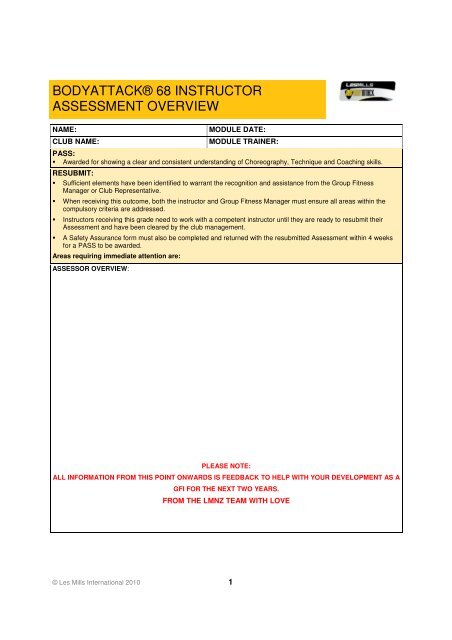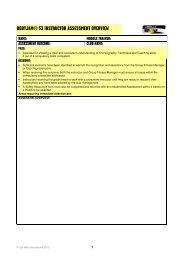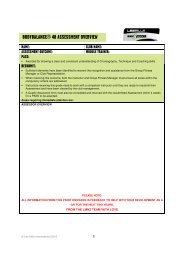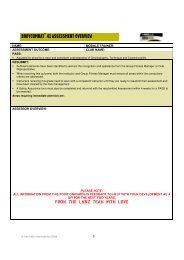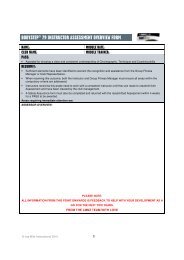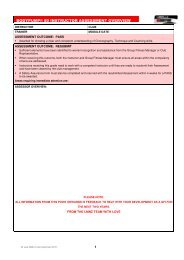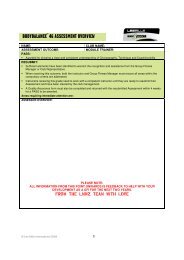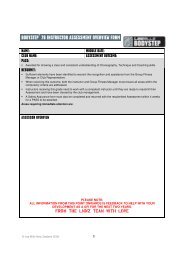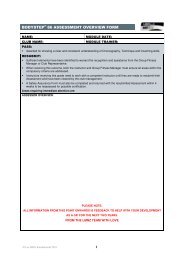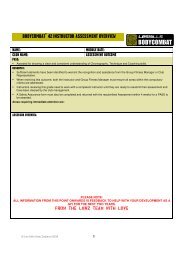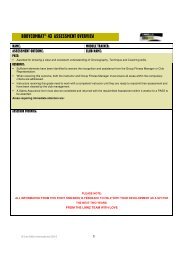bodyattack® 68 instructor assessment overview - Les Mills
bodyattack® 68 instructor assessment overview - Les Mills
bodyattack® 68 instructor assessment overview - Les Mills
Create successful ePaper yourself
Turn your PDF publications into a flip-book with our unique Google optimized e-Paper software.
BODYATTACK® <strong>68</strong> INSTRUCTORASSESSMENT OVERVIEWNAME:CLUB NAME:MODULE DATE:MODULE TRAINER:PASS: Awarded for showing a clear and consistent understanding of Choreography, Technique and Coaching skills.RESUBMIT: Sufficient elements have been identified to warrant the recognition and assistance from the Group FitnessManager or Club Representative.When receiving this outcome, both the <strong>instructor</strong> and Group Fitness Manager must ensure all areas within thecompulsory criteria are addressed.Instructors receiving this grade need to work with a competent <strong>instructor</strong> until they are ready to resubmit theirAssessment and have been cleared by the club management.A Safety Assurance form must also be completed and returned with the resubmitted Assessment within 4 weeksfor a PASS to be awarded.Areas requiring immediate attention are:ASSESSOR OVERVIEW:PLEASE NOTE:ALL INFORMATION FROM THIS POINT ONWARDS IS FEEDBACK TO HELP WITH YOUR DEVELOPMENT AS AGFI FOR THE NEXT TWO YEARS.FROM THE LMNZ TEAM WITH LOVE© <strong>Les</strong> <strong>Mills</strong> International 2010 1
BODYATTACK® <strong>68</strong> KEY ELEMENTSASSESSMENT FORMThis form provides a ‘snapshot’ of the areas requiring immediate attention. Any compulsory elements (indicated asbold) are to be addressed as a priority. Refer to your Program Manual and Release DVD to continue to develop theskills/elements highlighted below.Choreography COMPETENT DEVELOP THE HIGHLIGHTED SKILLSCorrectly delivers the choreography? Yes / No Choreography KnowledgeComments:Technique COMPETENT DEVELOP THE HIGHLIGHTED SKILLSDemonstrates correct alignment and posture? Yes / No PositionDemonstrates safe, effective movement and range? Yes / No ExecutionMoves in time with the music and on correct beat? Yes / No TimingDemonstrates strength and high-level conditioning? Yes / No FitnessDemonstrates the appropriate feel, look and attitude? Yes / No FeelComments:Coaching COMPETENT DEVELOP THE HIGHLIGHTED SKILLSIs easily understood and followed?Delivers the right information at the right time?Uses effective coaching language?Yes / NoYes / NoYes / NoInitial Cues / Follow-up Cues /Pre-cueingSequence of CuesVisual Instruction / Motivational Cues /CRC / VoiceIs organized? Yes / No Appearing Organized / Push Play andGoComments:NUMBER OF COMPULSORY SKILLS: 5 ACHIEVED:Connecting COMPETENT DEVELOP THE HIGHLIGHTED SKILLSEngages participants? Yes / S-T / No Engaging ParticipantsAppears open and approachable? Yes / S-T / No Open and ApproachableCaters to the needs of the class? Yes / S-T / No Catering to Your Classes’ NeedsComments:Fitness Magic COMPETENT DEVELOP THE HIGHLIGHTED SKILLSCaptures the essence of the program? Yes / S-T / No Capturing the Program EssenceCreates a journey of contrasts? Yes / S-T / No Contrasting the JourneyHas a natural teaching style? Yes / S-T / No Natural Teaching StyleComments:© <strong>Les</strong> <strong>Mills</strong> International 2010 2
BODYATTACK® <strong>68</strong> TRACK PRESENTATIONASSESSMENT FORMTo pass BODYATTACK® 3-month <strong>assessment</strong> you need to achieve competency in POSITION, EXECUTION and TIMING for theminimum number of moves prescribed below (Tracks 2-11). Each exercise is considered competent when you are successful in ALLbolded skills under that move.There are 8 bolded moves (cardio competencies) and 15 non-bolded moves in Tracks 1-4 and 6-9 (working tracks). In the boldedmoves, competency is necessary in 6 of 8 moves. In the non-bolded moves, competency is necessary in 11 of 15 moves. In theconditioning tracks (5, 10, & 11) there are 3 bolded moves (conditioning competencies). Competency is necessary in 2 moves.POSITION (P) competency is assessed against BODYATTACK® Set Position with key <strong>assessment</strong> skills noted at the top of eachlisted move.An X indicates any issues with the execution points listed. If a track exercise is not competent in POSITION, EXECUTION and/orTIMING, then an X will be placed in the appropriate column beside the move.PLEASE NOTE: The skills listed below each move are specific to this release. Each release has its own unique skills.TRACK 1: WARMUP POSITION EXECUTION TIMING FITNESS FEELSTEP TOUCHWALK FORWARD & BACKTAP REPEATERSTEP TOUCHTAP REPEATERChest up, shoulders back and down (P)Chest lifted, shoulders back and down (P)Step wide, heels on the floor, bring feet togetherWeight in the front leg with heel grounded (stay low)Knees bent, in line with middle of footKnee above and in line with middle toesDown & up movementWorking foot taps in and then extends back longArms Reach Forward (blades) to shoulder height and back (fists)Strong running arms – one fist shoulder height, other to hipWALK FORWARD & BACKChest lifted, shoulders back and down (P)Knee to hip height on walk forwardFoot flicks behind on walk backStrong running arms – one fist shoulder height, other to hipFITNESS: Maintain great technique throughout trackComments:FEEL: Upbeat and energizingTRACK 2: MIXED IMPACT POSITION EXECUTION TIMING FITNESS FEELSTEP CURLGALLOPPONYSTEP CURLPONYChest up, shoulders back and down (P)Chest up, shoulders back and down (P)Knees bent and in line with middle foot in Squat(not too deep)1, 2, 3 rhythm, light on the feetHeel curls towards butt and knee points to groundJump feet side-to-side, not up and downDown and up movementKnees and hips face frontBlade hands cross (chest height) and pull back to hips (fists)Double Arm Bicep Curl – fists curl towards headGALLOPChest lifted, shoulders back and down (P)2 steps side (heel into floor to push off) feet come together in themiddleCurl foot to butt at end of movementGo down and up, bending your knees© <strong>Les</strong> <strong>Mills</strong> International 2010 3
TRACK 8: INTERVAL POSITION EXECUTION TIMING FITNESS FEELRUN FORWARDKICKSKNEESRUN FORWARDKICKSChest up, shoulders back and down, feet hip-width apart (P)Chest up, shoulders back and down, feet hip-width apart (P)Toe/ball/heel landingSupporting heel towards the floorHeels towards buttKick from the hip and not the knee, leg straightSlight lean forwardKick to waist height, no higherDouble Arm Reach Up & Clap (blade hands, arms high/wide/fwdof shoulder)Punch Up and Forward – strong arms, opposite fist to waist,then Double Arm Punch DownKNEESChest up, shoulders back and down, feet hip-width apart (P)Hop on ball of foot, supporting heel towards the floorSide travelling movement (same side as lifted knee)Knee lifts to hip-height, toes pointedStrong Single Arm Bicep Curl/Single Arm PunchFITNESS: Maintain great technique throughout trackFEEL: Inspirational and upliftingComments:TRACK 9: POWER POSITION EXECUTION TIMING FITNESS FEELAIR JACKHEEL JACKAIR JACKHEEL JACKChest up, shoulders back and down (P)Deep knee bend into and out of jump. Straight arms and legs tothe four corners of the roomFITNESS: Maintain great technique throughout trackComments:Chest up, shoulders back and down (P)Feet jump out, then togetherWeight on supporting leg, opposite heel on ground(foot flexed)Hips and shoulders stay square to frontStrong arms - swing under chest to shoulder height,hands in fistsFEEL: Strong, peaking, tough and motivationalTRACK 10: LOWER BODY CONDITIONING POSITION EXECUTION TIMING FITNESS FEELFORWARD STEPPING LUNGEPOWER PULSE LUNGESQUATFORWARD STEPPING LUNGESQUATChest up, shoulders back and down, feet outsideChest up, shoulders back and down, feet hip-width (P)shoulder-width (P)Front knee above ankle and turned out over middle toesKnees out and above middle toesStep forward on diagonal – front heel groundedKeep butt above knee heightBack knee drops directly down towards floor: 90 – 90 positionHands cross chestPOWER PULSE LUNGEChest up, shoulders back and down, feet hip-width (P)Step forward and pulse lowFront knee above ankle and turned out over middle toesBack knee drops directly down towards floor: 90 – 90 positionFITNESS: Maintain great technique throughout trackFEEL: Strong, peaking, tough and motivationalComments:© <strong>Les</strong> <strong>Mills</strong> International 2010 6
TRACK 11: CORE CONDITIONING POSITION EXECUTION TIMING FITNESS FEELLEG EXTENSIONCRUNCHOBLIQUE CRUNCHLEG EXTENSIONPULSE CRUNCHRelax head and shoulders down. Keep back down (P)Chin tucks in, lower back on floor (P)Knees above hips, hands by sideKnees above hips, hands of floor, by sideExtend one leg out off floor, keeping extended knee still bent.Repeat with the other legLift/pulse upper body off floor, lower back stays on floorOBLIQUE CRUNCHChin tucks in, lower back on floor (P)Knees above hips, hands lightly behind earsBring opposite shoulder (not elbow) towards bent kneeKeep both hips on floorFITNESS: Maintain great technique throughout trackFEEL: ControlledComments:TRACK 12: COOLDOWN POSITION EXECUTION TIMING FITNESS FEELLOWER BACK TWISTKNEELING HIP FLEXOR ASTRETCHKNEELING HANSTRING ASTRETCHKNEELING ACHILLES ASTRETCHSTANDING CALF & TRICEP STRETCHSTANDING QUAD STRETCHSTANDING ADDUCTOR STRETCHCHESTCOMMENTS:A = CARDIO TOTALCOMPETENCIES ACHIEVED(bolded moves, tracks 1-4 & 6-9)P E T F FC = CARDIO TOTALCOMPETENCIES ACHIEVED(non-bolded exercises, tracks 1-4 & 6-9)JUMPING JACK (track 3) STEP TOUCH (track 1)PLYOMETRIC LUNGE (track4)WALK FORWARD & BACK(track 1)STRAIGHT JUMP (track 4) TAP REPEATER (track 1)PLYOMETRIC JUMP SQUAT(track 4) STEP CURL (track 2)HIGH KNEE RUN (track 6) GALLOP (track 2)AGILITY 3-STEP RUN - HEISMANSTYLE (track 7) PONY (track 2)KICKS (track 8) SHUFFLE (track 3)DOUBLE KNEE (&CROSSOVER) (track 3)AIR JACK (track 9)A= COMPETENCY ACHIEVED? min6/8 (Y/N) SUPERMAN (track 3)JOG BACK WITH FAST ARMCOMBO (track 6)P E T F F© <strong>Les</strong> <strong>Mills</strong> International 2010 7
DODGE HOP (track 7)B = CONDITIONING TOTALCOMPETENCIES ACHIEVED P E T F F(bolded moves, track 5, 10, & 11)FAST AGILITY RUN (track 7)TRICEPS PUSHUP (track 5) RUN FORWARD (track 8)CHEST PUSH UP (track 5) KNEES (track 8)B= OVERALL COMPETENCYACHIEVED? min 2/3 (Y/N)SQUAT (track 10) HEEL JACK (track 9)C= OVERALL COMPETENCYACHIEVED? min 9/15 (Y/N)OVERALL TECHNIQUECOMPETENCYTECHNIQUE COMPETENCY ACHIEVED?(A, B & C all YES)POSITION EXECUTION TIMING FITNESS FEELYES/NO YES/NO YES/NO YES/NO YES/NOMINIMUM COMPETENCY BEFOREAUTOMATIC RESUBMIT (A+B)6/11 6/11 6/11AUTOMATIC RESUBMIT YES or NA YES or NA YES or NA© <strong>Les</strong> <strong>Mills</strong> International 2010 8
INSTRUCTOR ACTION PLAN ANDFEEDBACK FORMS1. CHOREOGRAPHY:Was the choreography delivered correctly?Choreography is important to successful instructing and great classes are produced in the same way as other performing arts.Instructors are like the actors, for whom writers produce the lines that can be worked on to make them stars!With a choreographed track, we are released from having to create new tracks and are free to enhance the other skills that are essentialfor a great workout…Choreography is the core of the <strong>Les</strong> <strong>Mills</strong> system and, as such, a high level of importance is placed on an <strong>instructor</strong>’s ability to deliverthe choreography exactly as written.Action Plan (Drills):Choreography Knowledge(Compulsory)Listen to the music – in the car, at home, everywhereWatch your DVD over and over againMake notes about sequencesTry to anticipate the sequence of dance movements and tempo given to the specific trackReview and confer with choreography notes.Go to Quarterly Release days and watch expert role modelsPractice in front of mirrors until competency has been achievedPractice, practice… and practice again2. TECHNIQUE:Were you an example of role model technique?Role-modeling perfect technique is our way of showing and teaching high-energy, intense movements safely and effectively.As BODYATTACK <strong>instructor</strong>s, our objective is to take our class to a high cardiovascular output zone, whilst ensuring our classesremain user-friendly, safe and accessible to all fitness levels.Consistent focus on coaching the Attack Position, correct alignment and safe range of motion will ensure an <strong>instructor</strong> achieves thesegoals.Action Plan (Drills):Suggestions to assist you with Technique masteryEXECUTION and POSITION: (Compulsory)Participants often exaggerate what they perceive an <strong>instructor</strong> presenting. Try to keep target zones accurate and conservative andkeep unnecessary movement to a minimum.Watch and participate in <strong>Les</strong> <strong>Mills</strong> technique DVDs. Watch these carefully and listen to the cues that are used – note how it ‘feels’ tobe coached into the correct position.Review the Instructor Program Manual and check the choreography notes and Quarterly Release Handbook.Perfect our own physical technique! We can’t demonstrate clearly unless our own physical technique is perfect, so we need topractice and prepare our presentations of tracks in front of mirrors.Develop correct kinesthetic awareness with the mirror and then without.Film your class to check target zones and perform ongoing self-<strong>assessment</strong>s. Use the Assessment documents in your ProgramManual to assist you self-assess.TIMING: (Compulsory) Practice with different music pieces. Focus on smooth, constant, strong movement that uses full music counts.FITNESS: Integrate the BODYATTACK Instructor Challenge into your training schedule.FEEL:Practice executing an exercise incorporating the look and feel of athleticism, strength, energy and control where applicable. Use yourbody language and facial expressions in support of the technique.© <strong>Les</strong> <strong>Mills</strong> International 2010 9
3. COACHINGWere you easily understood and followed?A great coach knows exactly where they are taking their class.Each new release track introduces a Coaching Focus, which represents the essence of the track and highlights the intent of thechoreography.As you script and prepare each track, put together the most important experience you want to share with your participants. Ensure yourobjective is aligned with the choreographer’s Coaching Focus and supports the essence of the track and program.To achieve this, there is a need to be both well prepared and highly organized.An <strong>instructor</strong>’s ability to coach their participants to success is evident in a willingness to connect and develop their class. This can beachieved by ongoing focus and development of their instructional techniques and coaching methods.Action Plan (Drills):Sequence of Coaching Initial Cues(Compulsory) Follow-up Cues(Compulsory) Pre-cueing(Compulsory)Suggestions to assist you with Coaching masteryInitial Cues (Compulsory) are used in our movement setup. They are the ‘must-do’ elements ofthe movement. They’re simple, technical, clear and concise and they tell your participants exactlywhat to do to ensure correct and safe movement execution.You should use a minimum of 2 and a maximum of 5 cues for each exercise setup.Remember our up-and-coming participants as well as our long-standing devotees. Consistentlyreinforce the safety aspects, sound posture and alignment early in the track where the benefits aregreatest.Provide options, previews and acknowledgement when necessary and try to perceive where thedifficult areas are for your participants to ensure that they, too, feel successful.Explain the benefits to your class. This gives them a feeling of empowerment through expertunderstanding and also gives them reasons for coming back.Follow-up Cues (Compulsory) are used to create positive change. They coach your class andevolve, extend or enhance the feel of their movements, ensuring that they are moving even closerto the perfect technique!Interaction with your class is often possible in the middle of a track. Follow up by scripting usefulexamples and images from your experience that add to intensity, movement quality andenjoyment to the exercise.Explain the benefits to your class. This gives them a feeling of empowerment through expertunderstanding and also gives them reasons for coming back.Follow-up Cues include CRC cuesPre-cueing (Compulsory) Try to prepare participants and maintain flow throughout the class bypre-cueing and preparing your class with adequate time for changes (usually4 – 8 counts prior to the change).Practice with a partner by clearly explaining tempo and movement changes in advance. Practiceuntil your partner is completely successful with the movement. Use clear, strong delivery that ispositively and dynamically scripted.Always assume there are new people and recognize that for some it may take longer to learn themovement patterns.Visual Instruction Practice non-verbal cues with a partner (using fingers, face, and body gestures) and find newways to express the information visually.Motivational Cues Motivational Cues can be used throughout the track and increased at the end when theparticipants need more support and energy to complete on a ‘high’. Experiment with various ways of delivering the same information to keep your delivery fresh andinnovative and to avoid your class ‘tuning out’ over time. Even the more experienced participantsin class appreciate the basics being covered in new and innovative ways. Use scripting sheets and your own choreography notes to ‘create’ appropriate cues throughout thetrack. Use the three different phases of each track to fully maximize your class delivery! Believe in your participants – give them positive feedback.Technique Correction(CRC)Utilize the CRC technique correction model as often as possible. Build into your scripts variousways to ‘zone in’ on common mistakes and learn how to coach your participants, whilst leadingfrom the front.If you script and know what to say and when to say it, you will allow time and freedom to focus ontechnique correction. Start with a general comment and use non-threatening body language to© <strong>Les</strong> <strong>Mills</strong> International 2010 10
Action Plan (Drills):Suggestions to assist you with Coaching masteryhelp class members to improve their technique. This valuable teaching tool will become automatic the more frequently you put it into practice. Look for opportunities to improve participant technique.Voice Practice contrasting your vocal pitch and tone. Video your class or use a voice recorder. Listen without watching and ask yourself: “Do I haveimpact?” “Does my voice mirror the music?” and “Am I clear and easy to understand?” Practice delivering a track to the back of someone and have them pretend they have noknowledge. Offer them cues that get them doing the right thing at the right time. Are you clear andeasy to understand and follow?Appearing Organized Think about your class well in advance and create a ‘to do’ list. Allow yourself plenty of timeimmediately before the class to prepare, and make sure you get to class early. Set up the room: Test the microphone and music levels. Have CDs, back-up CDs, water and towelorganized. Script the beginning and end of each track – know where you are taking your class. Try to maintain visual contact with your participants as often as possible. Avoid turning your back on your class and maintain visual contact with every participant. Be organized and always have a ‘Plan B’.Push Play and Go Be efficient and expert in your transitions, plan to know what you have to prepare your class forand keep your class flowing. Stop the music only where absolutely necessary or as recommended by the program structureand choreographers.4. CONNECTINGDid you engage your participants based on the following criteria?Our ability to connect is the single most important element for growing class numbers and retaining happy participants.Making lasting connections is evident in an <strong>instructor</strong>’s hosting skills and willingness to add to the social experience of their participants.Great communicators draw from a wide variety of methods to interact with as many people as possible, being open and approachable,providing acknowledgement, praise and support for each person as both an individual and as part of a team.Action Plan (Drills):Suggestions to assist you with Connecting masteryEngaging Participants Scan the entire room during each track, ensuring that you make eye contact with every individual. Hold eye contact long enough that you may share a smile, a laugh or even an expression to showyou understand and care about the level of effort required. Find ways in which you can positively influence participant effort by scripting in cues that create asense of ‘team’ and ‘empowerment’. Include them regularly throughout the class. Let your passion for the music and exercises show.© <strong>Les</strong> <strong>Mills</strong> International 2010 11
Open and Approachable You will find that as soon as you get to know someone, the power of your communication withthem improves dramatically. Organize at least 10 minutes before and after class to introduceyourself to any new people and screen any injuries and pregnancy. Try to learn their names, sothey can be called by their name in class. A “Winning Beginning” will relax your class and get you into a good communication zone.Explaining technique and benefits to your class gives them a feeling of empowerment throughexpert understanding and also gives them reasons for coming back. Start always with a structured and enthusiastic introduction, which will inspire your participantsand emphasize their decision to be there. During your introduction invite the class to leave their day and their worries behind. This helps toestablish a mind/body connection and allows learning to happen, because the brain can often beengaged and overloaded. Share something personal about yourself that helps your class to appreciate who you are. Letthem get to know you and build small details of your life into your script. Show your enjoymentand tell your participants what you like. In every class, share something like your favorite song,track etc. Deliver your pre and post-class scripts with confidence and caring. Talk like you expect aresponse and be consistent in your delivery. Encourage open feedback by making statements like“If anyone is new, please come and see me...” or “If you want me to review any of the exercises,please come and talk to me.” ‘Go that extra mile’ – find ways to add value for your participants.Catering to your Class Every single group will be different, each and every day. The key to creating connections in classwill be directly related to your willingness and ability to adapt your behavior to the group in front ofyou. Think constantly about whom you’re doing it for and how you’re going to connect with them... Beavailable for questions, share a new technique tip, remember someone’s birthday (and make afuss)... Provide options, distribute handouts, free class passes, have a raffle, play music before class to‘set the scene’ or include special lighting, posters and/or ‘props’.5. FITNESS MAGICDid you stay true to the essence of BODYATTACK?Creating Fitness Magic is important because by making our class an experience we allow exercise to become more enjoyable andeasier to commit to.Fitness Magic is evident in an <strong>instructor</strong>’s willingness to teach with feeling and in the way we show our emotions by interpreting themusic.Accomplished <strong>instructor</strong>s who add elements of magic into their classes are often able to attract large numbers of participants — which isone of our main goals. They are also able to engage their participants in a positive social experience.When the other four key elements begin to come together you’ll begin to see magic. The biggest thing we can do as <strong>instructor</strong>s is let themusic, movement and essence of the program create this and just hang on for the ride!BODYATTACK provides the framework into which we can build our own special touches and create the stage for a magicalexperience that lifts our participants out of everyday life.“While we aim to be star performers we remain team players.”Action Plan (Drills):The Program EssenceContrasting the Journey BODYATTACK is a high-energy cardio-conditioning fitness class inspired by sportstraining that leaves you on a ‘high’! When we stand in the essence of the program it’s easy to take the next step in building ourperformance with the way we use the music. Use the power, strength, athleticism and energy in each track and create a blend of music,movement and flair! BODYATTACK projects feelings of excitement, energy, fitness and sports training. Toconvey these feelings and ‘set the stage’ for participants we must dress to naturally portraythis. Video and review the class. Critically assess your grooming and clothing. Ask yourself “Whatcan be changed to add to your presentation?” Contrast can be found within and between tracks.© <strong>Les</strong> <strong>Mills</strong> International 2010 12
Action Plan (Drills): Some tracks are fun, some are strong and others are high-energy. Everyone has differenttastes in music so it is important to learn to express the energy highs and lows according tothe nature of each song and the nature of the track. As we begin the process of learning each new release, focus on really working with the song,rather than being at odds with it. Prepare a class plan; identify high-energy points and strength points. Ensure you knowwhere you are taking the class and alter the intensity and approach you have to each track. As it is important to be able to create different feels within each track, ask yourself: “What isthe song’s energy level?” Get to really know the new release music – take it apart like a surgeon would, workingthrough all the layers and exposing its heart… then put it all back together again.There’s no need to go in search of a magic box of tools… it’s all there in the music, justwaiting for you. Maximize the music potential and let your class know about any ‘Magic’ moments that allowthem to join in and express themselves too! Challenge yourself and overcome feelings of self-consciousness and worries. Unlock theperformer within and build your stage confidence, reacting to situations naturally and taking arisk. When we teach, we must unlock our personality in ways that add new aspects to the class toincrease the entertainment value for participants. Be free to express yourself in a dynamicand ‘larger than life’ manner. Learn to improvise by acting and reacting to different situations. Practice dramatizing your vocals, recording your class or use a voice recorder and listen toyourself without watching and ask: “Do I have impact? Does my voice mirror the music?” And“What does the song feel like?” Ask yourself: “Is this song strong, energetic, relaxing,powerful, hard core, happy, serious, exciting or inspiring?” Once this is completed, matchyour verbal and physical delivery style to copy it. Create fantastic finales, where appropriate. Find the soul in each track and teach it with passion!Natural Teaching Style Relax and just be you! Teach from the heart with a voice that is natural and YOURS! Get to know your strengths to ensure your delivery is always upbeat and positive. There is agreat deal that can be said with a smile, cheeky grin or knowing look. Take what you do seriously, not yourself. Practice your favorite facial expressions and observe your body language in front of a mirrorand think about how people would see you – remember that perception is reality. Love what you do and show it!© <strong>Les</strong> <strong>Mills</strong> International 2010 13


